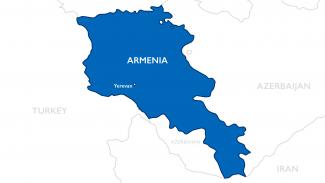
WHY USAID/OTI IS IN ARMENIA
The United States Government (USG) is supporting the Government of Armenia (GoAM) as it continues on its democratic reform trajectory and towards Euro-Atlantic integration. On September 19, 2024, Azerbaijan launched a 24-hour military offensive in Nagorno-Karabakh, causing a humanitarian crisis and displacing over 100,000 ethnic Armenians to regions across Armenia. The GoAM has been working to include the displaced population in Armenian society. The USAID/OTI's Armenia Support Engagement (ASE) provides strategic communications and other urgent support to the GoAM as it pursues long-term inclusion of those displaced from Nagorno-Karabakh. The program's objectives align with the USG's goals in the Caucasus, which include assisting Armenia to succeed as a secure, prosperous, sovereign, and democratic country.
USAID/OTI’s ROLE IN ARMENIA
USAID/OTI’s Armenia program focuses on enabling the GoAM to continue its democratic reform trajectory by mitigating tensions caused by the Nagorno-Karabakh (NK) crisis. The program seeks to:
- Strengthen the GoAM's ability to undertake data-driven strategic communications; and
Help the government, including local officials, demonstrate progress towards inclusion of the NK displaced through concrete and symbolic actions that respond to their priorities.
PROGRAM HIGHLIGHTS
USAID/OTI provided technical advisors to the GoAM's Office of the Prime Minister to develop its strategy to communicate the services the GoAM is providing to the displaced people from Nagorno-Karabakh (NK). Through these efforts, USAID/OTI helped the GoAM demonstrate progress towards inclusion of those displaced to the Armenian population.
USAID/OTI increased the call service center capacity of the Ministry of Labor and Social Affairs (MLSA), which provides technical and administrative support to the Armenian population, including those displaced from NK. Through this activity, the MLSA increased the number of hotline operations from 12 to 16. Calls to the center have more than doubled in recent months as displaced people have reached out for information. The additional capacity has been critical in helping the government respond to inquiries and communicate about its delivery of services.
2019 - 2022
WHY USAID/OTI WAS IN ARMENIA
In April 2018, peaceful protests across Armenia, known as the Velvet Revolution, culminated in the resignation of Prime Minister (PM) and former President, Serzh Sargsyan. In May 2018, Armenians elected protest leader and opposition parliamentarian Nikol Pashinyan as the new PM, launching a democratic transition. While the new Government of Armenia (GoAM) focused on its reform agenda, the COVID-19 pandemic and conflict in the Nagorno-Karabakh region significantly stressed the young administration. The program’s initiatives were to advance the USG’s goals in the Caucasus, which include assisting Armenia to succeed as a secure, prosperous, and democratic country that is better able to fight corruption and improve governance.
USAID/OTI’s ROLE IN ARMENIA
USAID/OTI’s Armenia program focused on sustaining positive momentum for the post-revolution government to improve prospects for enduring democracy in Armenia. The program sought to:
- Advance reforms in the executive branch of the GoAM and key public institutions that improve transparency and reduce corruption; and
Address emerging challenges that could threaten citizens’ confidence in democratic governance.
PROGRAM HIGHLIGHTS
USAID/OTI augmented the GoAM’s reform agenda by providing technical assistance, equipment, and training to ministries, press secretaries, governors, and the PM’s Office. Through these efforts, USAID/OTI helped the GoAM demonstrate progress to its citizens, who are eager for the change promised during the Velvet Revolution.
USAID/OTI supported the GoAM’s immediate efforts to mitigate COVID-19’s impact through technical assistance for strategic communications, IT equipment for emergency response and telework, medical supplies and surge personnel, and food packages for vulnerable families. The program’s response to rapid requests during this period allowed USAID/OTI to be at the forefront of the USG’s early response to the COVID-19, while seeking to ensure that the crisis does not undermine citizen confidence in democratic governance.
USAID/OTI enabled local governments to address citizens’ needs by providing in-kind assistance to resolve community-identified issues, thus demonstrating that the democratic government prioritized the needs of all Armenians. The assistance USAID/OTI provided helped to meet community priorities in Syunik Marz--with a specific focus on newly-designated border villages and other areas affected by the conflict--such as livelihoods assistance and psychosocial support.
